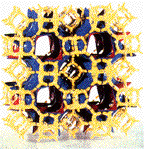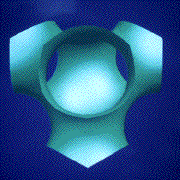Stephen
Hyde
Research interests:
My research spans a variety
of disciplines, but is directed to the single goal: understanding the
role of curvature in condensed atomic and molecular materials. These
materials include:
|


|
lyotropic liquid
crystals (made up of soaps/detergents/lipids and
water)
cell
membranes
block
copolymers
biominerals,
especially mineralisation of calcite in sea-urchin shells
(image at left)
zeolites (eg. Linde
type A, on left, click here for more)
mesoporous
inorganics, including clays
chiral thermotropic
liquid crystals
novel carbon
polymorphs, including buckytubes and hypothetical
schwarzites
|
My own work is largely
theoretical, but I prefer to work closely with experimentalists. I do
some experiments myself (mainly small-angle X-ray scattering studies
and related calorimetry and optical microscopy work); students and
postdocs. tend to be experimentalists to keep my feet somewhere
approaching terra
firma. To that end
we have access to a range of equipment, both within the dept. and on
campus:
- small-angle X-ray
cameras (one Guinier optics, one Kiessig pinhole camera)
- conventional wide-angle
X-ray cameras
- calorimeters
- optical
microscopy
- porosity/surface area
equipment
- atomic force
microscopy/scanning tunnel microscopy
- a variety of scanning
and transmission electron microscopes

This materials work is
underpinned by fundamental theoretical work, devoted principally to
investigations of hyperbolic surfaces, and their role in describing
structure and properties of both crystalline and liquid crystalline
materials, at a variety of length scales, from a few
Ångströms (zeolites, other covalent frameworks), to the
meso-scale (10-100Å), found in lyotropic liquid crystals and,
in some inorganic materials, such as novel hypothetical carbon
polymorphs ("schwarzites"), clays and alumino-silicates (imogolite,
allophane, etc.), and up to the micron scale in blue phases of
thermotropic liquid crystals and some sea-urchin skeletons.


|
The study of
hyperbolic surfaces involves techniques from differential
geometry and topology, and is largely devoted to triply
periodic minimal surfaces. These periodic examples arise
naturally if the surface is constrained to have nearly
constant (negative Gaussian) curvature and to be
intersection-free. Simpler examples have asymptotically flat
"ends", or eventually fold through themselves (as in the
example of the generalised Enneper minimal surface, shown
above).
Exact
parametrisation techniques have been developed to allow
computations of the lower genus surfaces, including cubic,
rhombohedral, tetragonal, etc., examples.
To date, the
simplest triply periodic minimal surfaces have been seen in
condensed materials. These are the famous P (top left), D
(bottom left)and G(yroid) surfaces. It is my suspicion that
a larger variety of structures will be uncovered,
particularly those of genus three and rhombohedral and
tetragonal symmetry, given more accurate structural probes.
An emerging area of
interest is that of a two-dimensional hyperbolic description
of three-dimensional networks, such as the covalent
frameworks of silicates. A few images of examples, generated
by Stuart Ramsden at the ANU Vizlab, can be found
elsewhere. That description is
appealing, as it offers simple relations between the ring
sizes in the net, and its three-dimensional density. This
approach may also offer some useful insights into
coordination sequences of nets, which are a useful
fingerprint of a net topology, and exhibit curious
polynomial relations.
|
This work is done in
collaboration with a number of people in Applied Mathematics,
especially Rob
Corkery and
Fiona
Meldrum, and groups
in Japan (Kyoto, Hashimoto group), Sweden (Lund, Andrew Fogden;
Malmö, Zoltan Blum), the U.S. (Arizona, Michael O'Keeffe) and
looser links elsewhere. If you have any queries about my work, please
contact me. I can be accessed from this page via email.
Selected recent publications:
- "The Language of
Shape", with S.
Andersson, K. Larsson, Z. Blum, S. Lidin, T. Landh and B. Ninham,
Elsevier, 1997. (Reviewed in Nature, vol. 387, p. 249.)
- "Bicontinuous
structures in lyotropic liquid crystals and crystalline hyperbolic
surfaces", Current Opinion in Solid State and Materials
Science, vol. 1,
pp. 653-662 (1996).
- "Microdomain
structures with hyperbolic interfaces in block and graft copolymer
systems", with H.
Hasegawa and T. Hashimoto, Polymer, vol. 37, pp. 3825-3833 (1996).
- "Elastic warping of graphitic
carbon sheets: relative energies of some fullerenes, schwarzites
and buckytubes", with M. O'Keeffe, Phil. Trans. Roy. Soc. Lond. A, vol. 354, pp. 1999-2008
(1996).
- "Parametrization of triply periodic
minimal surfaces", with A. Fogden, Acta Cryst. ,vol. A48, pp. 575-591 (1992).
- "Asymptotic behaviour of coordination
sequences for the 4-connected nets of zeolites and related
structures",with M. O'Keeffe,
Z. Kristallogr., vol. 211, pp. 73-78 (1996).
updated March, 1998.




